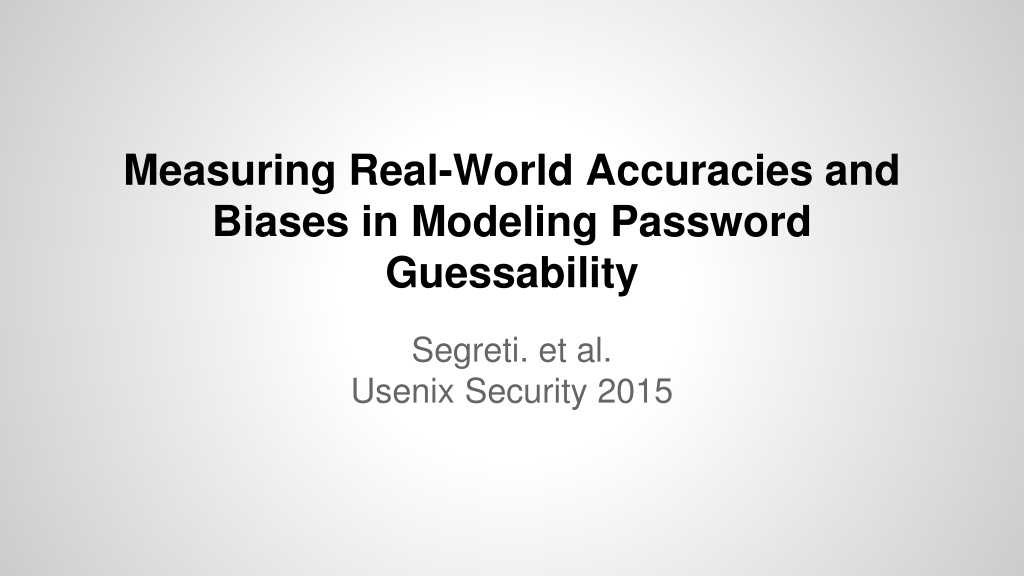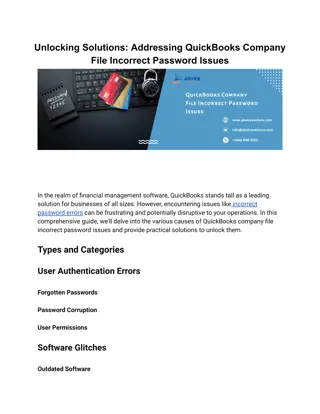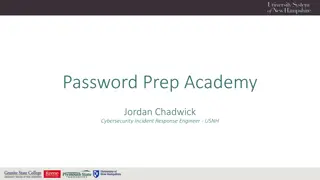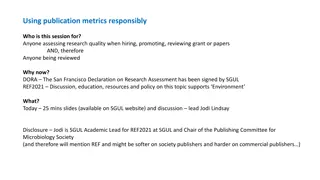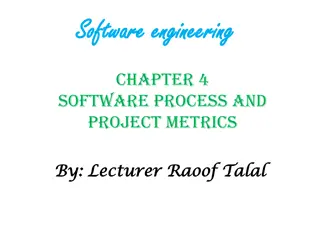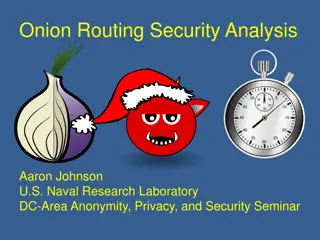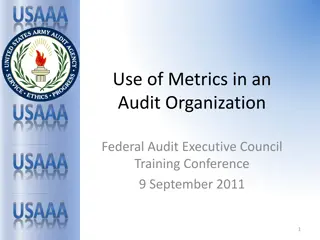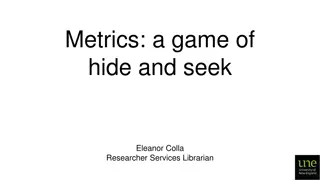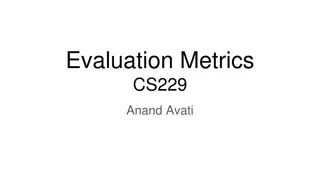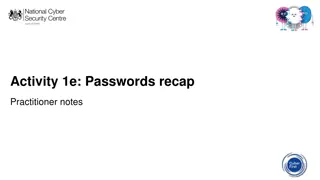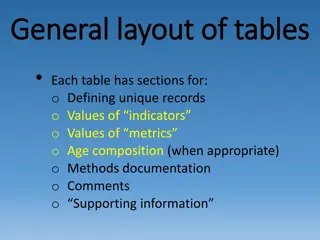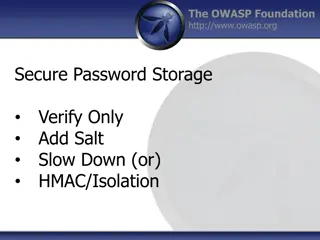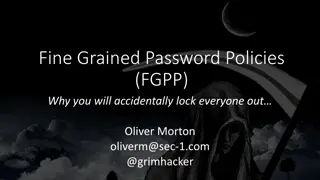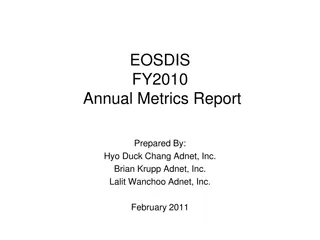Understanding Password Guessability Metrics in Real-World Security
Delve into the realm of password guessability metrics to enhance password security. Explore how measuring guessability aids in eliminating weak passwords, aiding users in creating stronger ones, and assessing security against various cracking algorithms. Uncover the significance of statistical and parameterized metrics, along with insights into cracking algorithms like brute-force attacks, mask attacks, PCFG, and Markov models.
Download Presentation

Please find below an Image/Link to download the presentation.
The content on the website is provided AS IS for your information and personal use only. It may not be sold, licensed, or shared on other websites without obtaining consent from the author. Download presentation by click this link. If you encounter any issues during the download, it is possible that the publisher has removed the file from their server.
E N D
Presentation Transcript
Measuring Real-World Accuracies and Biases in Modeling Password Guessability Segreti. et al. Usenix Security 2015
What is password guessability? It measures how easy to guess a password. Bad password: password , Iloveyou Good password: qw3^D)Z1 , j@mesb0nd007! Different ways: Traditional: Shannon Entropy (not practical) NIST Entropy (rule based) Currently: -guesswork Parameterized metrics
Why measures password guessability? 1.Eliminate bad passwords. Organizational password audits 2. Help users create better passwords. Provide feedback
Password Guessability Metrics Statistical metrics -guesswork it takes 1 million guesses for an attacker to guess 10% of passwords in a password set measures password set as a whole Parameterized metrics Investigate guessability under a cracking algorithm (simulate an attacker) measures guessability of individual password. security against real-world attacks, not idealized attacks. Does it accurately model real-world attackers? Does the attacker run only one algorithm?
Cracking Algorithm Brute-force and mask Attacks Dumbly iterate all possibilities Mask attacks first give a mask and then iterate e.g. choose L6D1 start from aaaaaa0, aaaaaa1, aaaaaa2, etc Mangled wordlists attacks (may be the most popular) given a dictionary that contains possible passwords mangling rules e.g. password -> p@ssword
Cracking Algorithm Probabilistic context-free grammar (PCFG) Train using real-world passwords (usually from breached password set) Build a password distribution model ranks password structure by probability e.g. p(L3D3S1) = 0.05% ranks special characters and numbers by probability e.g. p(123|D3) = 0.04%, e.g. p(!|S1) = 20% insert characters using an external library e.g. has 50 L3 entries. p(L3) = 1/50 Generate password guess by descending probability: e.g. p( abc123! ) = 0.05% * 0.04% * 20% * 1/50
Cracking Algorithm Markov Models Train using real-world passwords (usually from breached password set) Choose an order, build markov models and compute probability of guesses. e.g order-5 markov model, what is the probability of abcde ? p(abcd) = 10% p(e|abcd) = 80% p(bcde|end) = 30% p( abcde ) = 10% * 80% * 30% try guesses in descending probability order
This paper will... Analyze 4 automated cracking algorithm and 1 manual cracking method. Show that a single cracking algorithm relatively out-of-box produces a poor estimate of password guessability. Uncover the export procedure - using multiple well- configured algorithm in parallel.
This paper What to expect from this paper: Measurement, comparison of existing password cracking algorithm. comparison of algorithm efficiencies between researcher and attacker. What not to expect from this paper Novel technique or algorithm New system
Dataset (testing data) 13,345 passwords created under composition policies. Amazon Mechanical Turk Basic: 8+ chars Complex: 8+ chars, containing 4 character classes LongBasic: 16+ chars, LongComplex: 16+ chars, containing 4 character classes 15,000 from rockyou leak and 15,000 from Yahoo leak
Dataset (Training data) Breaches of MySpace, Rockyou, and Yahoo Dictionaries (19.4m in total): Single words from Google Web Corpus UNIX dictionary 250,000 words inflection dictionary
Simulating Password Cracking PCFG Markov-Model John the Ripper Hashcat Professional Cracker (Done by a security company - KoreLogic)
KoreLogic - professional cracker 1. Use JTR and Hashcat with proprietary wordlists, mangling rules, mask lists, and Markov models 2. Optimized over 10 years of password auditing 3. Dynamically update their mangling rules 4. Attack a. Complex b.Long c.Long Complex
Results - Configuration out-of-the-box configurations commonly used by researchers substantially underestimate password vulnerability. Hashcat different configuration PCFG and Markov Model Training Data Conclusion: Unoptimized configuration means underestimation the vulnerabilities
Guessing by automated approaches Attack Baisc Passwords Attack Long Passwords
Guessing by automated approaches Attack LongBasic Passwords Attack LongComplex Passwords
Guessed portion of password Limite: 10^(14) guesses
Guessing by pros Automated Approaches guess more in early stage An analyst wrote free-style rules at 10^(13) guesses, which significantly increase the cracked passwords Min_auto metric is a conservative approximation of the success of Pros
Limited Professional Cracking Attack 4239 complex passwords
Difference between approaches - Coverage Basic Password On contrast: LongBasic Shared: 6% 28% of Complex, LongBasic, and LongComplex passwords were guessed only by a single approach.
Difference between approaches - Char types Passwords contain only lower-case characters Also different in other settings
Difference between approaches - Different Policies Pro Attack Automated Attack (all attacking algorithms)
Conclusion A single guessing algorithm -> poor estimation several well-configured algorithms -> fairly good estimation of real attackers Different approaches have different outcome
Questions 1. why do we measure password strength? (2 main reasons) 2. Why is measuring password strength difficult? 3. What should a researcher do to make his estimation of password strength more accurate?
Questions 1. why do we measure password strength? (2 main reasons) 2. Why is measuring password strength difficult? 3. What should a researcher do to make his estimation of password strength more accurate?
